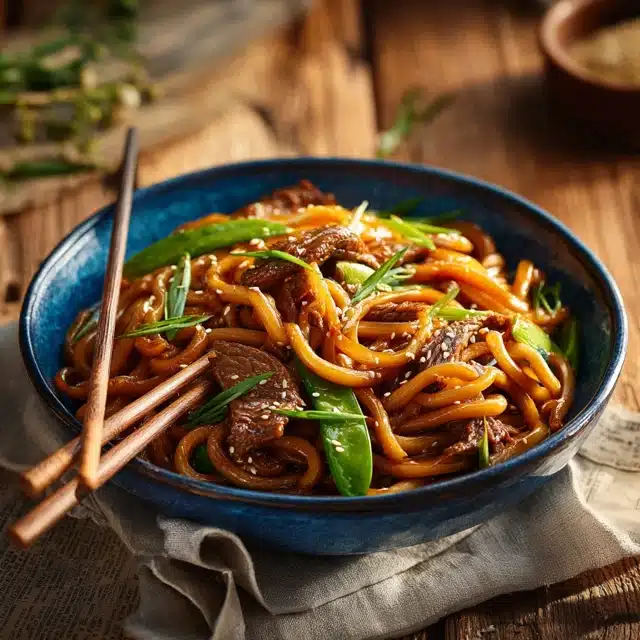Irresistible Yaki Udon Noodle Recipe for Comfort Food Lovers
Yaki Udon is the ultimate comfort food for noodle lovers—a savory, umami-rich stir-fried dish made with thick, chewy udon noodles, crisp vegetables, and a flavorful soy-based sauce. It’s quick, incredibly satisfying, and endlessly customizable with whatever protein or veggies you have on hand. Whether you’re craving authentic Japanese noodle recipes, looking for a quick Asian dinner, or just in the mood for a bowl of noodles that feels like a warm hug, Yaki Udon is the perfect answer.
Originally from Japan, this traditional noodle dish is a close cousin to yakisoba, but instead of thin wheat noodles, it uses hearty udon—making it more filling and rich in texture. Yaki Udon is often served in izakayas (Japanese pubs) as a late-night snack, but it’s just as fitting for a weekday dinner, lazy weekend lunch, or meal prep bowl.
Ingredients Overview
Here’s a breakdown of the essential elements that make Yaki Udon so delicious:
Udon Noodles
Thick and chewy udon noodles are the backbone of this dish. They soak up sauce beautifully and hold their texture even after stir-frying.
-
Frozen udon is the best option—it’s pre-cooked and retains the perfect texture.
-
Vacuum-sealed udon (shelf-stable) is a good alternative, just rinse well before using.
-
Dried udon requires boiling and draining—don’t overcook!
Protein
While optional, protein turns Yaki Udon into a full, balanced meal.
-
Chicken: Thinly sliced thigh or breast.
-
Shrimp: Peeled, deveined, and quick-cooked.
-
Beef: Thin-sliced steak like sirloin or ribeye.
-
Tofu: For a vegetarian version, pan-fry tofu until golden and crisp.
-
Egg: Add a fried egg or scrambled egg to the noodles.
Vegetables
Use what you have—crisp and colorful is the goal.
-
Cabbage (Napa or green): Adds crunch and sweetness.
-
Carrots: Julienned or sliced thin.
-
Onions: Sweet or yellow onions, thinly sliced.
-
Mushrooms: Shiitake, oyster, or button add umami.
-
Bell Peppers, Scallions, Baby Bok Choy are all great choices.
Sauce
The soul of Yaki Udon lies in its sauce—simple but packed with flavor.
-
Soy Sauce: The salty base.
-
Oyster Sauce: Adds deep umami and slight sweetness.
-
Mirin: A sweet rice wine that balances the salty elements.
-
Sesame Oil: For that nutty aroma.
-
Optional: Sake or rice vinegar, for more complexity.
Garnishes
-
Toasted sesame seeds
-
Thinly sliced scallions
-
Bonito flakes (for an authentic touch)
-
Shichimi togarashi (Japanese 7-spice) for heat
Step-by-Step Instructions
This dish comes together in just 20–25 minutes. Here’s how to make it:
1. Prepare the Udon
If using frozen udon, place it in hot water for 1–2 minutes to loosen, then drain and set aside. If using dried udon, boil until just al dente, drain, and rinse with cold water.
2. Make the Sauce
In a small bowl, whisk together:
-
2 tbsp soy sauce
-
1 tbsp oyster sauce
-
1 tbsp mirin
-
1 tsp sesame oil
Set aside.
3. Cook the Protein
Heat 1 tbsp neutral oil (like canola or avocado) in a large skillet or wok over medium-high heat. Add your protein of choice and cook until browned and just cooked through. Remove and set aside.
4. Stir-Fry the Vegetables
In the same pan, add another splash of oil. Add onions and harder vegetables like carrots first. Stir-fry for 2 minutes. Then add mushrooms and cabbage. Cook for 3–4 more minutes, until veggies are tender-crisp.
5. Add Noodles and Sauce
Add cooked udon noodles to the pan, followed by your sauce. Use tongs to toss everything together so the noodles are fully coated. If needed, add a splash of water to loosen the noodles and help the sauce spread evenly.
6. Return Protein and Finish
Return your cooked protein to the pan. Toss everything together and cook another minute or two until heated through and well combined.
7. Garnish and Serve
Serve hot, topped with sesame seeds, scallions, and shichimi togarashi if you like a little kick.
Tips, Variations, and Substitutions
Yaki Udon is incredibly flexible, making it perfect for cleaning out the fridge or adapting to different diets.
Tips for Best Results
-
High Heat: Cook on medium-high to high heat for that quick, wok-seared flavor.
-
Don’t Overcrowd the Pan: Cook in batches if needed to avoid steaming the ingredients.
-
Use Tongs: They make tossing the thick noodles much easier.
Variations
-
Spicy Yaki Udon: Add sriracha, chili garlic sauce, or use spicy sesame oil.
-
Yaki Udon with Egg: Crack an egg into the pan and scramble into the noodles before serving.
-
Peanut-Style Sauce: Mix soy sauce with a spoonful of peanut butter, chili oil, and rice vinegar for a fusion twist.
Substitutions
-
Gluten-Free: Use tamari instead of soy sauce and check labels on oyster sauce (or use gluten-free alternatives).
-
Vegetarian: Skip meat and use tofu; substitute mushroom-based sauce for oyster sauce.
-
Low-Sodium: Use low-sodium soy sauce and omit added salt.
Serving Ideas & Occasions
This is the kind of dish that works any time of day—and for almost any situation:
-
Weeknight Dinner: Fast, satisfying, and better than takeout.
-
Lunch Bowl: Pack into containers and reheat easily.
-
Late-Night Comfort Food: Just like in Japanese izakayas.
-
Side Dish for Entertaining: Serve smaller portions alongside sushi, dumplings, or grilled skewers.
-
Meal Prep: Store in the fridge up to 4 days. Add a splash of water when reheating.
Pair it with miso soup, pickled vegetables, or a fresh cucumber salad for a full Japanese-inspired meal.
Nutritional & Health Notes
Yaki Udon can be surprisingly balanced when made at home:
-
Noodles: Udon provides complex carbs and energy. Look for whole grain udon if available.
-
Protein: Add chicken, tofu, shrimp, or egg to make it a complete meal.
-
Vegetables: Load up with mushrooms, cabbage, carrots, and greens for fiber and nutrients.
-
Lower Fat Option: Use minimal oil, skip sesame oil, or substitute with broth for sautéing.
Keep portions balanced and the sauce light for a nourishing, flavorful dish.
FAQ
1. What’s the difference between Yaki Udon and regular udon soup?
Yaki Udon is stir-fried and typically dry (no broth), while regular udon is served in soup with a dashi-based broth. Both use the same noodles but have very different flavors and textures.
2. Can I make Yaki Udon vegetarian or vegan?
Yes! Use tofu or extra vegetables as the protein and replace oyster sauce with a mushroom stir-fry sauce or vegan oyster sauce.
3. Can I use spaghetti if I don’t have udon?
In a pinch, yes. While it won’t have the same chew, spaghetti or linguine can work as a substitute for the noodle base.
4. What’s the best way to store leftovers?
Let cool, then store in an airtight container in the fridge for up to 4 days. Reheat in a skillet with a splash of water to loosen the sauce.
5. Can I use pre-cooked meat?
Yes! Leftover grilled chicken, pork, or beef works well. Just slice thin and toss in at the end to heat through.
6. Is Yaki Udon spicy?
Not usually. It has a savory, umami flavor. You can add spice with chili flakes, shichimi togarashi, or sriracha.
7. What sauce is used in Yaki Udon?
A simple combo of soy sauce, oyster sauce, mirin, and sesame oil. You can adjust to taste with sake, rice vinegar, or chili oil.
Authentic Yaki Udon Recipe – Easy Japanese Comfort Food
Yaki Udon is a quick, stir-fried Japanese noodle dish made with thick udon noodles, savory sauce, crisp vegetables, and optional protein. It’s easy, comforting, and full of umami flavor.
- Prep Time: 10 minutes
- Cook Time: 15 minutes
- Total Time: 25 minutes
- Yield: 4 servings 1x
Ingredients
-
12 oz udon noodles (fresh or frozen)
-
2 tbsp neutral oil (for stir-frying)
-
1 small onion, thinly sliced
-
1 cup shredded cabbage
-
½ cup julienned carrots
-
½ cup mushrooms, sliced
-
1 cup protein (chicken, shrimp, tofu – optional)
-
2 tbsp soy sauce
-
1 tbsp oyster sauce
-
1 tbsp mirin
-
1 tsp sesame oil
-
Salt and pepper to taste
-
Scallions, sesame seeds, chili flakes (for garnish)
Instructions
-
Prepare udon noodles and set aside.
-
In a small bowl, whisk together soy sauce, oyster sauce, mirin, and sesame oil.
-
Heat oil in a skillet or wok. Cook protein until done; remove and set aside.
-
Stir-fry onions and hard veggies for 2–3 minutes. Add mushrooms and cabbage, cook 2–3 more minutes.
-
Add noodles and sauce. Toss well. Add splash of water if needed.
-
Return protein to pan. Stir to combine and heat through.
-
Garnish and serve hot.
Notes
-
Use pre-cut stir-fry veggies to save time.
-
Substitute tofu for a vegetarian version.
-
Reheat leftovers in a skillet with a splash of water.

